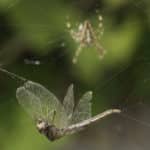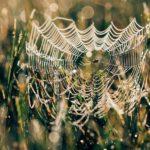 If you’ve ever walked through a doorway, only to find a spider has decided to build a 3-bedroom condo right at face level, then you are familiar with the enigma (or perhaps the horror, for some) of the spider web. If you’re anything like me, you also discovered a hidden talent know as the“spastic kung-fu disco step-aerobics thrash about spider web dance.” Either way, it does make one wonder; precisely what are spider webs?
If you’ve ever walked through a doorway, only to find a spider has decided to build a 3-bedroom condo right at face level, then you are familiar with the enigma (or perhaps the horror, for some) of the spider web. If you’re anything like me, you also discovered a hidden talent know as the“spastic kung-fu disco step-aerobics thrash about spider web dance.” Either way, it does make one wonder; precisely what are spider webs?
Got Spiders? Call a knowledgeable licensed professional at 1-800-323-7378 or contact us to request a FREE Quote, ask us a question or Schedule a Service!
What are they made of, and why are they made?
What?
Webs are made of a protein-based silk material. Spiders create the silk in special glands and spin the webs by use of their spinnerets, which are located at the tip of their abdomen. Each gland produces a thread for a specific purpose. For example, a safety line for travel, sticky silk for trapping prey, or a more delicate silk for wrapping it. Some spiders can produce up to eight different types of silks. Most spiders have between 1 and four pairs of spinnerets, each having its own unique function.
Why?
 Not all spiders build webs, but the ones that do, make a variety of different styles. The webs not only provide a home for some spiders, but it allows them to catch their prey with very little energy expenditure. Building the web itself does cost the spider a lot of energy, due mainly to the massive amounts of protein required to manufacture the silk. They can regain some of this lost energy by recycling their webs. They do this by actually consuming it when it loses its stickiness, which it does over time. Way to go green, spiders!
Not all spiders build webs, but the ones that do, make a variety of different styles. The webs not only provide a home for some spiders, but it allows them to catch their prey with very little energy expenditure. Building the web itself does cost the spider a lot of energy, due mainly to the massive amounts of protein required to manufacture the silk. They can regain some of this lost energy by recycling their webs. They do this by actually consuming it when it loses its stickiness, which it does over time. Way to go green, spiders!
One thing all spiders have in common is that their very presence in your home may be an indication of a more serious pest infestation. This is because spiders feed off of other common household pests.
How?
The tensile strength of spider silk is greater than the same weight of steel and is far more flexible. Science has long sought to capitalize on this wonder of nature, experimenting with its industrial uses in everything from bullet-proof vests to artificial tendons. Some have even tried to get other animals to be able to synthesize their own spider webs, but that research is still ongoing. Many years ago, spider webs were used as gauze bandages to help stop bleeding in wounds. They are rich in vitamin K.
Types.
 There are numerous types of spider webs, depending on the species. Orb webs, the vertical spiral webs that most people associate with spiders, are very common. Then there are the classic cobwebs, messy, seemingly disorganized strands that occupy dark corners. Some types of ground spiders produce funnel webs, where they can lie hidden, waiting for their prey to happen by, before emerging to pounce. An interesting spider is a net-casting spider, which spins a small web that it suspends between it’s two front legs, and then ambushes it’s prey, wrapping it up as it attacks.
There are numerous types of spider webs, depending on the species. Orb webs, the vertical spiral webs that most people associate with spiders, are very common. Then there are the classic cobwebs, messy, seemingly disorganized strands that occupy dark corners. Some types of ground spiders produce funnel webs, where they can lie hidden, waiting for their prey to happen by, before emerging to pounce. An interesting spider is a net-casting spider, which spins a small web that it suspends between it’s two front legs, and then ambushes it’s prey, wrapping it up as it attacks.
The Modern Difference
 No matter the type of spider, their webs are fascinating. One of the strongest, most versatile creations found anywhere in nature; they are integral to the survival of the species. That bit of information, while interesting — is not a factor when you plunge face-first into a sticky work of art in your darkened basement. Our HomeCare Green service provides year-round protection from 60 different types of pests – including spiders!
No matter the type of spider, their webs are fascinating. One of the strongest, most versatile creations found anywhere in nature; they are integral to the survival of the species. That bit of information, while interesting — is not a factor when you plunge face-first into a sticky work of art in your darkened basement. Our HomeCare Green service provides year-round protection from 60 different types of pests – including spiders!
While spiders do play an important role in the control of many insects, if you DO NOT prefer to share your home or office with too many eight-legged intruders, contact the folks at Modern Pest Services. 1-800-323-7378.
Our highly trained pro’s can help you design a plan that will keep you from ever having to do the spider web dance again.
